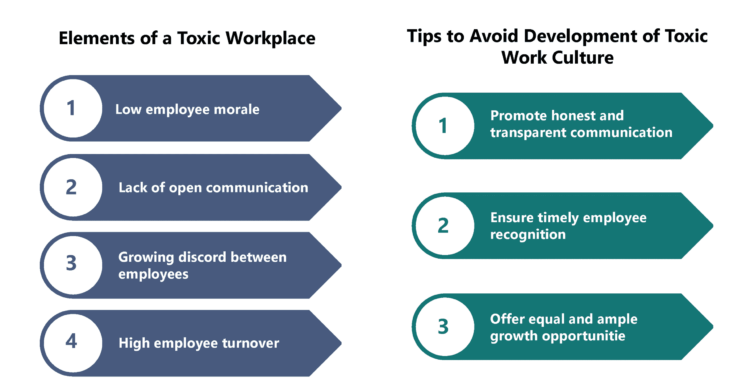1. Characteristics of Toxic Culture: Signs include low employee morale, lack of open communication, employee discord, and high turnover due to stress and dissatisfaction.
2. Impact of Toxicity: A toxic work culture can lead to falling productivity, employee disengagement, and damage to the organization’s reputation and growth.
4. Prevention Strategies: Promote honest and transparent communication, ensure timely employee recognition, and provide equal career growth opportunities to prevent the occurrence of toxic behaviors.
5. Fostering a Positive Culture: Organizations must maintain a healthy, inclusive, collaborative environment to avoid a toxic culture and support long-term success.
Organizations strive to cultivate a positive work culture that drives employee engagement, which is crucial for business growth and a competitive advantage. However, there is a fine line between a driven work environment and a hyper-competitive one with a toxic workplace culture.

Contrary to popular belief, toxic workplace culture is not just about inefficient and unproductive employees within the organization.
Rather it is more about a workplace plagued with infighting, falling productivity, unhappiness, and dissatisfaction among employees.
In most cases, the elements of toxic work culture are readily apparent and thus easily identifiable.
They often remain hidden and require significant effort from the senior leaders to be uncovered.
The most common signs of a toxic organizational culture are as follows:

When many employees show little interest in their work or surroundings, it indicates growing toxicity in the workplace.
Lack of energy and enthusiasm among employees should be taken quite seriously by the leaders.
Hence, they should focus on identifying the reasons for this and rectifying them as soon as possible.

Lack of effective communication between the employees and the management is another significant indicator of a toxic work culture.
Employees often feel afraid to ask questions to their supervisors and simply choose to follow their instructions.
Hence, this can build their sense of distrust and even make them feel disengaged and undervalued.

The growing discord between employees indicates that not all is well at the workplace.
An increase in misunderstanding between co-workers, the decline in collaboration, and growing distrust and dissent among employees are all red flags.
Hence, organizations must notice and respond to them as soon as possible.

One of the key indicators of a toxic corporate culture is a high employee turnover rate.
Most employees prefer to leave their jobs rather than being bogged down by the stressful environment at the workplace.
High-performing and sincere employees tend to avoid workplace politics, as it can negatively impact their performance.
A toxic culture can have a profoundly negative impact on an organization, significantly decreasing productivity and eroding market goodwill.
Moreover, it can destroy the ethos of the organization and promote undesirable behaviors that will hinder business growth.
Hence, organizations must take the necessary steps to prevent the development of a toxic organizational culture.
The following tips can prove beneficial in this context:

Honest and transparent communication, both vertical and lateral, can help prevent the development of a toxic culture.
Hence, sharing timely information about business goals, processes, and policies with employees helps the organization in gaining their trust.
It also allows employees to express their opinions and ideas freely, strengthening their emotional connection with the organization.

Appreciating employees for their efforts and achievements effectively is key to keeping them happy and motivated.
Such employees are less likely to engage in activities that may disrupt the organization’s growth and profitability.
Hence, a good employee recognition program can ensure employees’ contributions to business success are recognized and appreciated.

Also, an organization needs to provide its employees with fair and ample career growth opportunities across levels.
Hence, organizations need to avoid bias or favoritism, which can breed dissent within the workforce.
Otherwise, it can lead to a significant drop in employee engagement and cause detachment and emotional disconnect.
Organizations need to ensure that avoid the pitfalls of a toxic work culture that is detrimental to the growth and profitability of the business.

Lead author: Sagar Chaudhuri, the Co-Founder and CEO of HiFives. He is an HR Tech Evangelist with over 25 years of experience in both corporate and entrepreneurial settings. Previously, Sagar has held leadership roles at companies including Genpact, Infosys, and ICICI Bank. He has an engineering degree from IIT Kharagpur and an MBA from IIM Lucknow. Connect on LinkedIn
To stay updated on the latest HiFives blogs, follow us on Twitter (@MyHiFives)